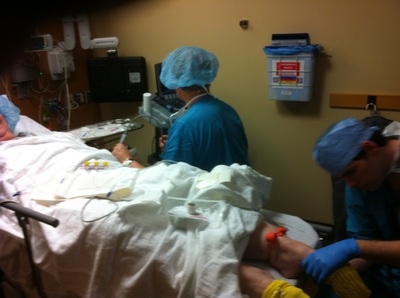|
Everything went well for my surgery yesterday at Virginia Mason. Of course it took longer to find a vein than to do the surgery. It took two doctors, two ultrasound machines and one nurse. Of course the nurse found a vein that would work, unfortunately it was in the arch of my left foot.
Groggy and exhausted Chuck and I left Seattle at 5:30, and joined a slow freeway crawl after a bad tanker truck crash outside of Dupont. We actually considered a hotel room.. Thank goodness my sister lives in Lakewood and we ended up spending the night at her house. Thanks Nancy! The surgery was to replace the lead to my sacral nerve stimulator which had dislodged from my spine in one of my many falls. I am happy to report so far so good with the stimulator on again.
1 Comment
What could these "misfolded" protein molecules be trying to create? A new design, practicing it's mutation without success up until now, that holds a vital evolutionary brain update, the very link to the unfolding of the human race?! Or is it just a misunderstood command to fold left instead of right? Whatever the cause I claim my new advanced brain pattern as Divine Creation.
Here is an amazing article from OHSU: OHSU researchers develop new drug approach that could lead to cures for wide range of diseases12/09/13 Portland, Ore. A team led by a longtime Oregon Health & Science University researcher has demonstrated in mice what could be a revolutionary new technique to cure a wide range of human diseases — from cystic fibrosis to cataracts to Alzheimer's disease — that are caused by "misfolded" protein molecules. Misfolded protein molecules, caused by gene mutation, are capable of maintaining their function but are misrouted within the cell and can’t work normally, thus causing disease. The OHSU team discovered a way to use small molecules that enter cells, fix the misfolded proteins and allow the proteins to move to the correct place and function normally again. The researchers were led by P. Michael Conn, Ph.D., who was a senior scientist in reproductive sciences and neuroscience at OHSU's Oregon National Primate Research Center and professor of physiology and pharmacology, cell biology and development and obstetrics and gynecology at OHSU for the past 19 years. This month, Conn joined Texas Tech University Health Sciences Center as senior vice president for research and associate provost. The team’s work will be published this week in the early online edition of the Proceedings of the National Academy of Sciences. The work was the culmination of 13 years of work on the process by Conn and Jo Ann Janovick, former senior research associate at the ONPRC who is now also at TTUHSC. Richard R. Behringer, Ph.D., from the University of Texas MD Anderson Cancer Center, M. David Stewart, Ph.D., from the University of Houston, and Douglas Stocco, Ph.D., and Pulak Manna, Ph.D., from the department of biochemistry/microbiology at TTUHSC, also contributed to the work. Conn and his team perfected the process in mice, curing them of a form of disease that causes males to be unable to father offspring. The identical disease occurs in humans and Conn believes the same concept can work to cure human disease as well. "The opportunity here is going to be enormous," said Conn, "because so many human diseases are caused by misfolded proteins. The ability of these drugs – called ‘pharmacoperones’ – to rescue misfolded proteins and return them to normalcy could someday be an underlying cure to a number of diseases. Drugs that act by regulating the trafficking of molecules within cells are a whole new way of thinking about treating disease.” Proteins must fold into three-dimensional shapes in precise ways to do their work within human cells. Before recent discoveries about misfolded proteins, scientists believed that proteins that were inactive were intrinsically non-functional. But work by Conn and others revealed that, when the proteins are misfolded, the cell's "quality control system" misroutes them within the cell and they cease to function only because of that misrouting. Pharmacoperones can fix misfolded proteins and thus make them functional again. Scientists had in recent years observed this process in cells under a microscope. The work of Conn's team is the first time the process has worked in a living laboratory animal. “These findings show how valuable laboratory animals are in identifying new treatments for human disease,” said Conn. “We expect that these studies will change the way drug companies look for drugs, since current screening procedures would have missed many useful pharmacoperone drugs.” A wide range of diseases are caused by an accumulation of misfolded proteins. Among the diseases are neurodegenerative diseases like Alzheimer's disease, Parkinson's disease and Huntington's disease. Other diseases include certain types of diabetes, inherited cataracts and cystic fibrosis. Conn said the next steps will be clinical trials to see whether the same technique can work in humans. The research was funded by the National Institutes of Health (grants OD012220 and DK85040), the Ben F. Love Endowment, the American Heart Association, the Texas Heart Institute and the Robert A. Welch Foundation. December 2013
My big news is that I have had my 3 month checkup and I do not have any further progression of neurological symptoms. I have been hunkered down and totally focused on my health the last three months and have made huge changes in my life. The main thing I am working on is creating a huge open space for healing to pour in. I am simply being me to the fullest, allowing myself to be sad and mad sometimes, but mostly I am really happy. I am surrounded by my family, I wake up to grandchildren getting ready for school, and a house filled with love, and I am overwhelmed by the generosity of my friends and family. Okay, enough of that… TOP TEN PLACES TO FAINT
|
Cathy Pfeil
Welcome to my blog. Here I will write about all things Cathy. Archives
December 2019
Categories |








 RSS Feed
RSS Feed
